 W
WBall boys and ball girls are individuals, usually youths, who retrieve and supply balls for players or officials in sports such as association football, American football, bandy, cricket, tennis, baseball and basketball. Though non-essential, their activities help to speed up play by reducing the amount of inactive time.
 W
WThe crash ball is an attacking tactic in rugby league and rugby union where a player receives a pass at pace and runs to the opposition's defensive line. The crash ball runner attempts to commit two or more opposing players to the tackle, then attempts to make the ball available to teammates by offloading in the tackle, performing a quick play-the-ball in rugby league, or recycling the ball quickly from the ruck in rugby union. By committing players to the tackle, the crash ball runner creates holes in the opposition's defense, thereby creating attacking opportunities for teammates.
 W
WA drop goal, field goal, dropped goal, or pot is a method of scoring points in rugby union and rugby league and also, rarely, in American football and Canadian football. A drop goal is scored by drop kicking the ball over the crossbar and between the goalposts. After the kick, the ball must not touch the ground before it goes over and through, although it may touch the crossbar. If the drop goal attempt is successful, play stops and the non-scoring team restarts play with a kick from halfway. If the kick is unsuccessful, the offside rules for a kick apply and play continues until a normal stoppage occurs. Because of the scoring attempt this is usually from the kicked ball going dead or into touch. Defenders may tackle the kicker while he is in possession of the ball, or attempt to charge down or block the kick.
 W
WA field goal, also called a flying kick or speculator, was a way of scoring in the game of rugby football. It consisted of a player kicking the ball from the ground without using their hands in open play over the crossbar. This method of scoring was abolished in rugby union in 1905 and in rugby league in 1950.
 W
WFive-eighth or Stand-off is one of the positions in a rugby league football team. Wearing jersey number 6, this player is one of the two half backs in a team, partnering the scrum-half. Sometimes known as the pivot or second receiver, in a traditional attacking 'back-line' play, the five-eighth would receive the ball from the scrum half, who is the first receiver of the ball from the dummy-half or hooker following a tackle.
 W
WIn several forms of football a forward pass is a throwing of the ball in the direction that the offensive team is trying to move, towards the defensive team's goal line. The forward pass is one of the main distinguishers between gridiron football in which the play is legal and widespread, and rugby football from which the North American games evolved, in which the play is illegal.
 W
WFullback is one of the positions in a rugby league football team. Typically wearing jersey number 1, the fullback is a member of the team's 'back-line'. The position's name comes from their duty of standing the furthest back in defence, behind the forwards (8-13), half backs and the three-quarter backs (2-5). Fullbacks are therefore the last line of defence, having to tackle any opposition players and regather the ball from any kicks that make it through their teammates. It is for this reason that the fullback is also referred to as the sweeper or custodian. Being able to secure high bomb kicks is a highly sought quality in fullbacks.
 W
WIn sport, a goal may refer to either an instance of scoring, or to the physical structure or area where an attacking team must send the ball or puck in order to score points. The structure of a goal varies from sport to sport, and one is placed at or near each end of the playing field for each team to defend. For many sports, each goal structure usually consists of two vertical posts, called goal posts, supporting a horizontal crossbar. A goal line marked on the playing surface between the goal posts demarcates the goal area. Thus, the objective is to send the ball or puck between the goal posts, under or over the crossbar, and across the goal line. Other sports may have other types of structures or areas where the ball or puck must pass through, such as the basketball hoop.
 W
WPrimarily in Australian sports, a grand final is a game that decides a sports league's premiership winning team, i.e. the conclusive game of a finals series. Synonymous with a championship game in North American sports, grand finals have become a significant part of Australian culture. The earliest leagues to feature a grand final were in Australian rules football, followed soon after by rugby league. Currently the largest grand finals are in the Australian Football League (AFL) and National Rugby League (NRL). Their popularity influenced other competitions such as soccer's A-League, the National Basketball League, Suncorp Super Netball and European rugby league's Super League to adopt grand finals as well. Most grand finals involve a prestigious award for the player voted best on field.
 W
WA high tackle is an illegal tackling move in rugby football. A high tackle occurs when a player tackles or attempts to tackle an opponent above the line of the shoulders, or makes contact with another players head or neck. The move is dangerous due to the risk of injury to the head and neck of the player being tackled.
 W
WHooker is one of the positions in a rugby league football team. Usually wearing jersey number 9, the hooker is one of the team's forwards. During scrums the hooker plays in the front row, and the position's name comes from their role of 'hooking' or 'raking' the ball back with the foot. For this reason the hooker is sometimes referred to as the rake.
 W
WIn sports, a loan involves a particular player being able to temporarily play for a club other than the one to which they are currently contracted. Loan deals may last from a few weeks to a full season, sometimes persisting for multiple seasons at a time.
 W
WThe penalty box or sin bin is the area in ice hockey, rugby union, rugby league, roller derby and some other sports where a player sits to serve the time of a given penalty, for an offence not severe enough to merit outright expulsion from the contest. Teams are generally not allowed to replace players who have been sent to the penalty box.
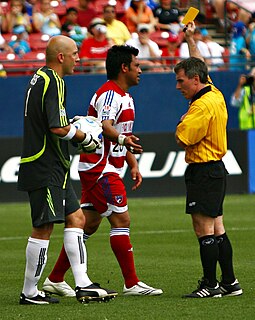 W
WPenalty cards are used in many sports as a means of warning, reprimanding or penalising a player, coach or team official. Penalty cards are most commonly used by referees or umpires to indicate that a player has committed an offence. The official will hold the card above his or her head while looking or pointing towards the player that has committed the offence. This action makes the decision clear to all players, as well as spectators and other officials in a manner that is language-neutral. The colour or shape of the card used by the official indicates the type or seriousness of the offence and the level of punishment that is to be applied. Yellow and red cards are the most common, typically indicating, respectively, cautions and dismissals.
 W
WThe place kick is a type of kicking play commonly used in American football, association football (soccer), Canadian football, rugby league, and rugby union.
 W
WPlayer escort (also called match mascot or child mascot is a child who accompanies football player entering the pitch. Player escorts hold hands with the footballer while they walk in and stay with the player during the playing of the national anthem. The children are usually between 6 and 18 years old. In addition to assisting players, they often have duties such as carrying flags, helping the sideline ball crew and playing matches with each other.
 W
WRepechage is a practice in series competitions that allows participants who failed to meet qualifying standards by a small margin to continue to the next round. A well known example is the wild card system.
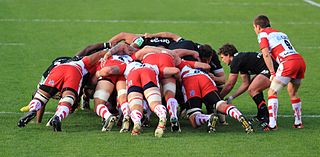 W
WA scrum is a method of restarting play in rugby football that involves players packing closely together with their heads down and attempting to gain possession of the ball. Depending on whether it is in rugby union or rugby league, the scrum is used either after an accidental infringement or when the ball has gone out of play. Scrums occur more often, and are now of greater importance, in union than in league. Starting play from the line of scrimmage in gridiron football is derived from the scrum.
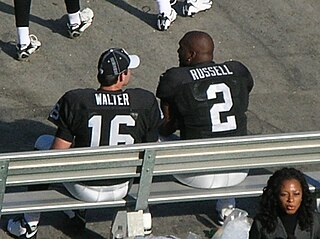 W
WThe "sidelines" are the white or colored lines which mark the outer boundaries of a sports field, running parallel to each other and perpendicular to the goal lines. The sidelines are also where the coaching staff and players out of play operate during a game. The area outside the sidelines is said to be out of bounds. The term is predominantly in use in American football, Canadian football, field lacrosse and basketball.
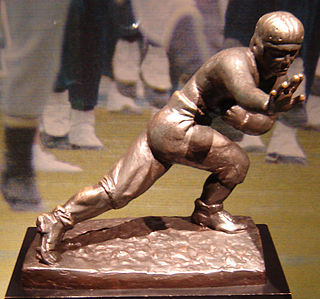 W
WThe stiff-arm fend is a tactic employed by the ball-carrier in many forms of contact football.
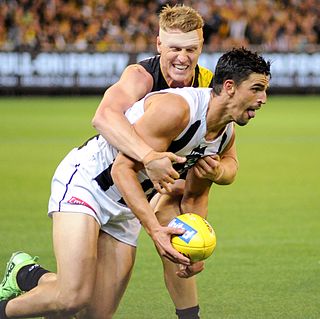 W
WMost forms of football have a move known as a tackle. The primary and important purposes of tackling are to dispossess an opponent of the ball, to stop the player from gaining ground towards goal or to stop them from carrying out what they intend.
 W
WA try is a way of scoring points in rugby union and rugby league football. A try is scored by grounding the ball in the opposition's in-goal area. Rugby union and league differ slightly in defining "grounding the ball" and the "in-goal" area.